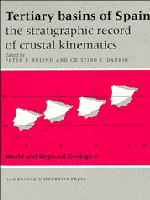Book contents
- Frontmatter
- Contents
- List of contributors
- Preface
- Dedication to Professor Oriol Riba IArderiu
- Memorial, Etienne Moissenet 1941–1994
- PART G GENERAL
- G1 Tertiary stages and ages, and some distinctive stratigraphic approaches
- G2 Cenozoic latitudes, positions and topography of the Iberian Peninsula
- G3 Tertiary tectonic framework of the Iberian Peninsula
- G4 Deep crustal expression of Tertiary basins in Spain
- G5 Oil and gas resources of the Tertiary basins of Spain
- G6 Mineral resources of the Tertiary deposits of Spain
- PART E EAST
- PART W WEST
- PART C CENTRE
- PART S SOUTH
- Index
G2 - Cenozoic latitudes, positions and topography of the Iberian Peninsula
Published online by Cambridge University Press: 04 August 2010
- Frontmatter
- Contents
- List of contributors
- Preface
- Dedication to Professor Oriol Riba IArderiu
- Memorial, Etienne Moissenet 1941–1994
- PART G GENERAL
- G1 Tertiary stages and ages, and some distinctive stratigraphic approaches
- G2 Cenozoic latitudes, positions and topography of the Iberian Peninsula
- G3 Tertiary tectonic framework of the Iberian Peninsula
- G4 Deep crustal expression of Tertiary basins in Spain
- G5 Oil and gas resources of the Tertiary basins of Spain
- G6 Mineral resources of the Tertiary deposits of Spain
- PART E EAST
- PART W WEST
- PART C CENTRE
- PART S SOUTH
- Index
Summary
Abstract
Four maps of the Iberian peninsula at 65, 35, 16 and 0 Ma show the positions of Iberia relative to Europe and Africa as estimated from ocean-floor spreading data. The maps themselves are in a global paleomagnetic reference frame. The Cenozoic changes in latitude of Seville, Madrid and Barcelona are also shown. In early Paleocene time the latitude of Seville was as low as 30δ. The origins of the present high topography of the Spanish meseta are unclear.
Introduction
The chapters in this volume discuss the Tertiary basins in Spain. The nature of their sedimentary fill is controlled partly by tectonics, paleoclimate and paleotopography. This short chapter comments on all of these features from a broader viewpoint than that which has necessarily been adopted by most of the accompanying chapters and also raises some general questions. In particular, this chapter highlights three topics: 1. Cenozoic positions of the Iberian peninsula relative to Eurasia and Africa as estimated from published Atlantic ocean-floor spreading data; 2. Cenozoic paleolatitudinal changes of the peninsula; and 3. the peninsula's anomalously high topography.
Cenozoic position and orientation
In Cenozoic time the Iberian peninsula has behaved as part of a microplate directly linked to Africa and Eurasia by orogenic belts. In principle, the position of the peninsula relative to the stable parts of the Eurasian and African plates can be determined by fixing Iberia and restoring the orogenic belts to their late Cretaceous shapes and then adjusting the positions of Eurasia and Africa accordingly.
- Type
- Chapter
- Information
- Tertiary Basins of SpainThe Stratigraphic Record of Crustal Kinematics, pp. 6 - 8Publisher: Cambridge University PressPrint publication year: 1996
- 3
- Cited by



